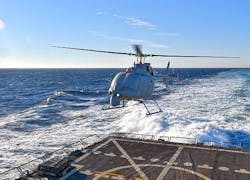Raytheon continues project to upgrade Fire Scout UAV control system with open-systems software
PATUXENT RIVER NAS, Md., 28 April 2016. Military drone experts at the Raytheon Co. will continue upgrading the MQ-8 Fire Scout unmanned aerial vehicle (UAV) control system with open-systems software to enhance interoperability among military UAV control systems, reduce costs, and facilitate future upgrades.
Officials of the U.S. Naval Air Systems Command at Patuxent River Naval Air Station, Md., announced a $21.6 million contract Wednesday to the Raytheon Technical Services Co. in Dulles, Va., for software upgrades involving the Fire Scout tactical control system (TCS) 2016 Linux cyber baseline.
The U.S. Navy Northrop Grumman MQ-8 Fire Scout unmanned aerial system (UAS) is an unmanned helicopter deployed on Navy destroyers, littoral combat ships, and other surface combatants for reconnaissance, situational awareness, and precision targeting.
Raytheon software engineers will continue switching software for the Fire Scout control system into compliance with the Pentagon's standard UAS Control Segment (UCS) architecture -- a framework of software-intensive capabilities of current and future U.S. military unmanned vehicles.
Raytheon has been working since 2014 to switch the Fire Scout tactical control system from Solaris to Linux software, and upgrade the system with universal UAV control qualities. The company also has upgraded the TCS full-motion video capability, its shipboard messaging formats, and training and simulation capabilities.
Wednesday's contract calls for Raytheon not only to switch Fire Scout software to the UCS architecture, but also to introduce modern intuitive controls; integrate SAU 7000 messaging; and test and support the software in the field.
The Raytheon TCS is designed to operate UAVs in all branches of the U.S. military, as well as NATO STANAG 4586-compliant UAVs. Raytheon developed the TCS to run on the proprietary Sun Microsystems Solaris 8 software operating system, which is approaching the end of its useful life in U.S. military applications.
The TCS can be configured in racks for ship-based operations, shelterized as a land-based system, or integrated into a shelter on land vehicles such as the HMMWV.
Related: UAV command, control & communications
There are five levels of TCS functionality. levels I and II enable receipt of imagery. levels III and IV provide command and control of the air vehicle and payload and imagery receipt. level V provides command-and-control, payload control, imagery receipt, and the ability to take off and land.
The UCS architecture came from the Pentagon's UCS working group -- a group of government and industry unmanned vehicle software experts. the architecture seeks to define a common functional architecture, interface standards, and business rules.
The architecture also aims at using open-source and government-owned software, and refining message sets. The first UAVs to receive the UCS software architecture are the Fire Scout, as well as the General Atomics MQ-1C Gray Eagle, MQ-1 Predator, and MQ-9 Reaper UAVs.
Later military drone aircraft experts will turn their attention to the Northrop Grumman MQ-4C Triton maritime patrol UAV and RQ-4 Global Hawk surveillance UAV. The architecture should be applicable to UAVs larger than 20 pounds that use networked line-of-sight and over-the-horizon communications.
Related: Navy issues urgent order to equip MQ-8 helicopter UAV with maritime surveillance radar
The UCS architecture involves a control segment architecture with standardized, government-owned UAV command-and-control interfaces for weapons, surveillance, tactical networking, and software applications.
Although the internal workings of the UCS architecture are expected to be similar, the initiative does not require each of its control system interfaces to look and feel the same. Instead, different UAV programs can operate individual human-machine interfaces based on their missions.
U.S. military leaders intend the UCS architecture to enable acquisition flexibility at system, subsystem, component, application, and service levels; encourage innovation; reuse software; make UAV control systems scalable; and make it easy to integrate new unmanned aircraft, sensors, weapons, and other payloads into existing UAV control systems.
On Wednesday contract Raytheon will do the work in Dulles, Va., and should be finished by October 2018. For more information contact Raytheon online at www.raytheon.com, Naval Air Systems Command at www.navair.navy.mil, or the UCS Architecture site at https://ucsarchitecture.org.

John Keller | Editor
John Keller is editor-in-chief of Military & Aerospace Electronics magazine, which provides extensive coverage and analysis of enabling electronic and optoelectronic technologies in military, space, and commercial aviation applications. A member of the Military & Aerospace Electronics staff since the magazine's founding in 1989, Mr. Keller took over as chief editor in 1995.

